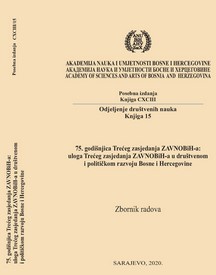OD OBNOVE DRŽAVNOSTI DO RAVNOPRAVNOSTI BOSNE I HERCEGOVINE U DEMOKRATSKOJ FEDERATIVNOJ JUGOSLAVIJI
FROM RESTORATION OF STATEHOOD TO EQUALITY OF BOSNIA AND HERZEGOVINA IN DEMOCRATIC FEDERAL YUGOSLAVIA
Author(s): Miodrag N. Simović, Mujo Demirović
Subject(s): History of Law, Constitutional Law, Civil Society, Political history, Government/Political systems, Politics and society, Interwar Period (1920 - 1939), WW II and following years (1940 - 1949), Inter-Ethnic Relations
Published by: Akademija Nauka i Umjetnosti Bosne i Hercegovine
Keywords: ZAVNOBiH; Bosnia and Herzegovina; AVNOJ; People’s Liberation Movement; national equality; citizen;
Summary/Abstract: During the Second World War, the People’s Liberation Movement (PLM) in Yugoslavia had several goals, of which the anti-fascist fight and liberation of the country stood out, as well as the building of a new democratic people’s government, i.e. a new socio-political system. In order to understand this, one must keep in mind the historical outcomes and activities of which stand out: (1) letters from the advanced Bosnian student youth of 1937, 1938 and 1939; (2) the leftist magazine „Putokazi“ from Zagreb, which was published for three years (1937, 1938 and 1939), with a total of 13 issues, edited by Skender Kulenović and Hasan Kikić, Zijo Dizdarević, Hamid Dizdar and Safet Krupić. The editor-in-chief was Šukrija Huskić and (3) the Fifth National Conference of the Communist Party of Yugoslavia in Zagreb from 19 to 23 October 1940, which paid special attention to Bosnia and Herzegovina. Understanding the anti-fascist fight of the PLM as a permanent civilizational-existential constant, in which all peoples and nationalities led by the PLM took part, the authors focus on building a new people’s democratic government. At the same time, they emphasize that the center of the PLM was in BiH, especially in Bosnian Krajina, where historical key events were held (two sessions of the National Anti-Fascist Council of People’s Liberation of Bosnia and Herzegovina - ZAVNOBiH in 1943 - in Mrkonjić Grad and 1944 in Sanski Most and two sessions of the Anti-Fascist Council of the People’s Liberation of Yugoslavia - AVNOJ - in 1942 in Bihać and in 1943 in Jajce). Thus, the development of the PLM and the building of new government in BiH were directly correlated. Eminent scientists (such as academician Enver Redžić) asses that these historical events happened under the pressure of successful development of the PLM and that they would have happened without the instructions of the PLM leadership, which does not question their role at all.
- Page Range: 103-122
- Page Count: 20
- Publication Year: 2020
- Language: Bosnian, Croatian, Serbian
- Content File-PDF

